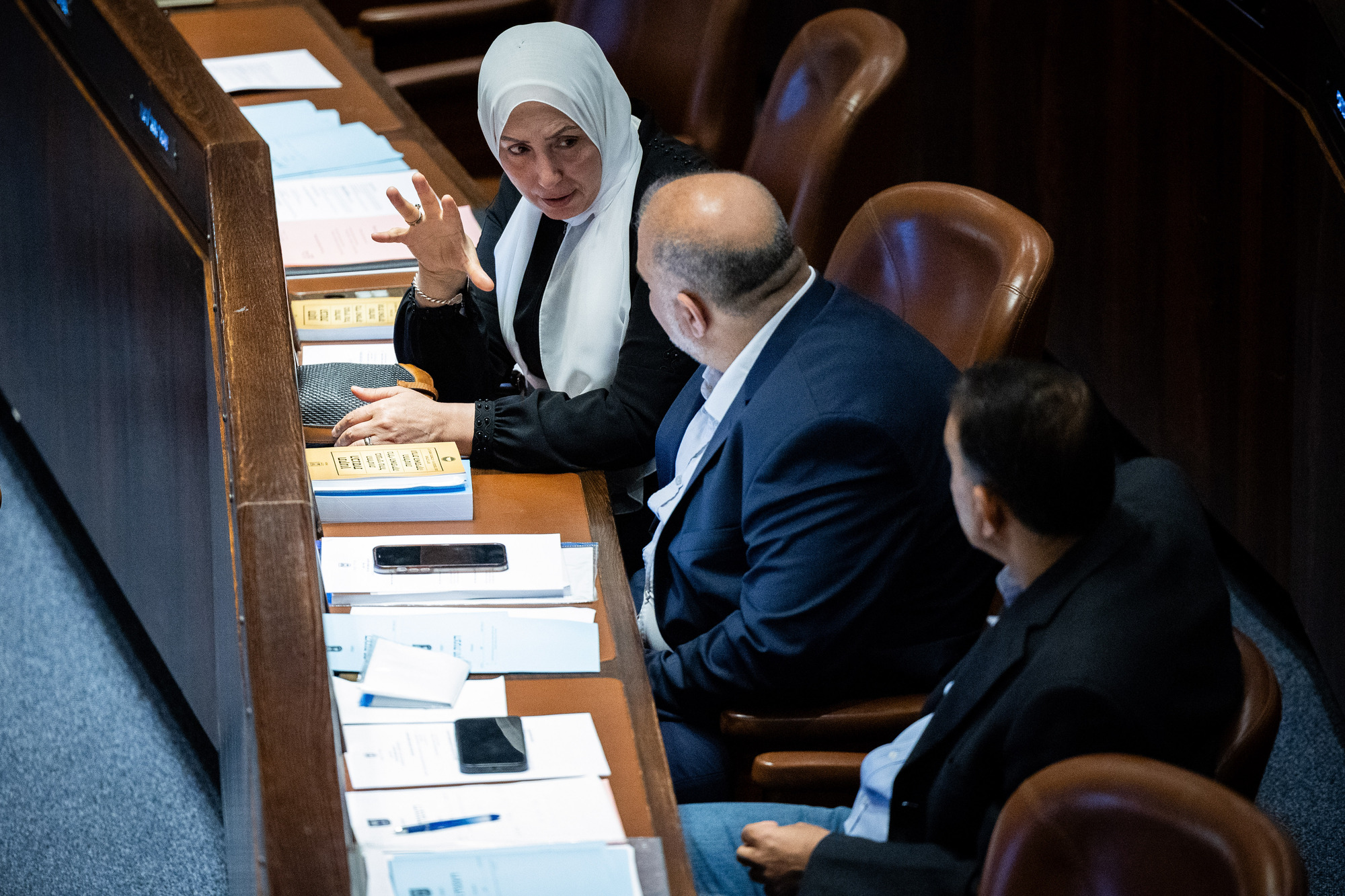Arab Representation in the Judiciary is Under Threat
By shifting power from professional bodies to political appointees the new law restructuring the Judicial Selection Committee is likely to reduce Arab representation and exacerbate their exclusion.

Arab MK's seen during a vote for representatives for the judge-picking panel at the assembly hall of the Knesset, the Israeli parliament in Jerusalem. Photo by Yonatan Sindel/Flash90
Behind the rhetoric of diversity lies a law that threatens to reduce representation, increase exclusion, and endanger the status of Arab judges.
Last week, the Knesset passed in its second and third readings a law proposed by Ministers Gideon Sa’ar and Yariv Levin to change the composition of the Judicial Selection Committee. According to the law, instead of two representatives from the Israel Bar Association, the committee will include two "public representatives"—qualified for appointment to the Supreme Court—who will be selected by the Knesset, one by the coalition and one by the opposition. Additionally, the two Knesset members serving on the committee will now also be chosen by the coalition and opposition, respectively. In effect, this proposal fundamentally alters the composition of the Judicial Selection Committee—shifting the balance of power from professional bodies (judges and lawyers) to elected officials and politicians.
While the reform is being presented as a means to enhance diversity in the judiciary, in practice, it is likely to achieve the opposite: reducing diversity and, most notably, harming the appointment of Arab judges and entrenching their exclusion from key positions in the judicial system.
Indeed, over the years, justified criticism has been leveled at the lack of diversity in the judiciary. Israel’s courts have been predominantly staffed by Ashkenazi Jewish men, while women, Arabs, Mizrahim, and residents of social-geographic peripheries have been underrepresented. Although recent decades have seen some improvement—increasing the number of women, Arabs, and judges from peripheral communities in the lower courts—significant gaps remain. Only about 8% of judges across the judiciary are Arab (less than half their proportion in the population), and, only one out of 12 Supreme Court justices is Arab. Regarding selection of Supreme Court justices, the committee has maintained an unwritten tradition—though not enshrined in law—whereby at least one Supreme Court justice is Arab. While this representation does not reflect the Arab population’s share in society, it demonstrates the committee’s commitment to inclusion in the Supreme Court—even if just symbolically.
The current composition of the Judicial Selection Committee—where professional members hold a relative majority—operates with an implicit recognition of the importance of representation and diversity, even if inadequately so. However, once control shifts to political hands, the likelihood of preserving this principle will be significantly diminished. Notably, in President Herzog’s proposed "People’s Framework," a proposed alternative to the 2023 judicial overhaul legislation, it was stated that one of the criteria the Judicial Selection Committee should consider when appointing judges is "reflecting the diversity of groups in Israeli society," and that at least one committee member should represent the Arab community. However, these considerations are now absent from the law. Currently, the only Arab member of the committee is one of the representatives of the Israel Bar Association, who, under the new law, will be removed from the committee.
The concern is straightforward: the Knesset members and political representatives appointed to the committee will operate based on political, ideological, and partisan considerations rather than a commitment to diversity or representation. The new mechanism for selecting judges will encourage political polarization and create incentives for each side to nominate the most extreme candidates who purely reflect its political stance. This incentive will come at the expense of appointing professional judges with broad consensus, thereby reducing social diversity. In this context, the appointment of Arab judges will become highly unlikely, as the Arab community itself is scarcely represented in the political arena, with both the coalition and opposition frequently dominated by non-Arab parties.
In several rulings, the Supreme Court has emphasized the state’s obligation to promote the representation of Arab citizens alongside other marginalized groups. For example, regarding representation in the Israel Land Authority, the Supreme Court for the first time recognized the emergence of a judicial doctrine requiring the state and its authorities to provide adequate representation for the Arab population across the entire public service sector in Israel.
The current composition of the Judicial Selection Committee, while imperfect, maintains a balance that (albeit with difficulty) allows for the advancement of this doctrine and the creation of a space where considerations of representation, diversity, and inclusion can be heard and taken into account. The concern is that once control shifts to politicians, and given the incentives created by the committee’s structure and decision-making process, these considerations will be sidelined.
The reform presents diversity as a goal—but in practice, it strips the concept of all substance. This is nothing more than rhetoric designed to legitimize a dangerous political move that could harm not only Arab representation but also the broader public’s trust in the judicial system.
An edited version of this column was published in Haaretz English.
- Tags:
- Arab Society,
- Right to Equality,
- The Renewed Judicial Overhaul,
- Judicial Overhaul Implications,
- The Judicial Selection Committee,
- The Judicial Overhaul,
- Democracy in Defense,
- Appointing Judges,
- High Court of Justice,
- social justice,
- Supreme Court,
- Arab Society in Israel Program,
- Democratic Values and Institutions Program,
- Center for Democratic Values and Institutions
